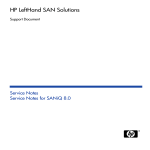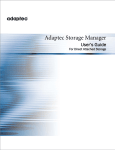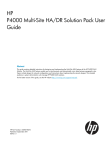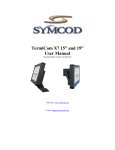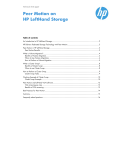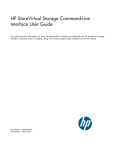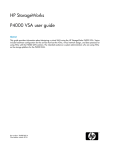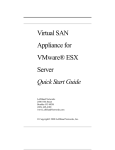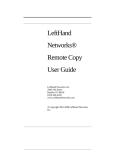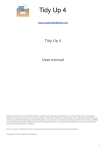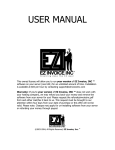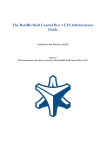Download The SAN/iQ Command Line Interface User Manual
Transcript
CLIQ
The SAN/iQ Command-Line Interface
User Manual
Overview
The SAN/iQ command-line interface (CLI) is built upon the SAN/iQ API released with
version 8.x. Develop your own automation, scripting and management using the CLI.
•
For instructions about using the CLI, see the Syntax section, immediately following
this introduction.
•
The section on Global Parameters describes functionality that applies to the entire
CLI and includes commands to customize global operations.
System Requirements
Windows Server 2003 SP1
Windows Server 2003 R2
Windows Server 2008
Windows Server 2008 R2
Windows XP SP2
Windows Vista
Windows 7
10 MB available space
Installing the CLI
Install the CLI from the HP LeftHand Management DVD. The installation wizard
automatically installs the command-line software to the following default location in
Windows:
C:\Program Files\LeftHand Networks\CLI
and sets the path.
Sample Scripts
You can obtain sample scripts from the HP LeftHand Networks web site at
http://www.lefthandnetworks.com/home.aspx
On-Node CLI
The CLI is installed on storage nodes and can be accessed by SSH.
•
Log in to the on-node CLI using the node IP address and the designated port 16022.
•
If logging in from a command line, you must type the following command:
ssh –p 16022 -l <user> <NSM-IP>
AX696-96003
March 2010
Commands
Syntax ............................................................................................................................................. 5
Parameter ordering ................................................................................................................................ 5
Case sensitivity ........................................................................................................................................ 5
True/False ................................................................................................................................................ 5
Command abbreviation ......................................................................................................................... 5
OS error code integration ...................................................................................................................... 5
Composite commands............................................................................................................................. 6
Size specification ..................................................................................................................................... 6
Password prompt .................................................................................................................................... 6
Key file ..................................................................................................................................................... 7
DNS names .............................................................................................................................................. 7
Storage Node CLI ................................................................................................................................... 7
Integrated command shell...................................................................................................................... 7
Global parameters .......................................................................................................................... 9
timeToWait=<milliseconds> .................................................................................................................. 9
prompt=<true | false> ............................................................................................................................. 9
output=<XML | Normal> ....................................................................................................................... 9
separator=<c> ......................................................................................................................................... 9
inputFile=<file> ...................................................................................................................................... 9
Commands .................................................................................................................................... 10
addVirtualManager .............................................................................................................................. 11
assignVolume ........................................................................................................................................ 12
assignVolumeChap ............................................................................................................................... 14
cacheCredentials ................................................................................................................................... 16
cancelRemoteSnapshot ......................................................................................................................... 17
clearCredentials .................................................................................................................................... 18
clearCredentials .................................................................................................................................... 19
clearCredentials .................................................................................................................................... 20
clearVssVolumeFlags ........................................................................................................................... 21
cloneSnapshot........................................................................................................................................ 22
configureRaid ........................................................................................................................................ 23
connectVolume ...................................................................................................................................... 24
convertSnapshotTempSpace................................................................................................................ 25
createAdminGroup............................................................................................................................... 26
2
createAdminUser .................................................................................................................................. 28
createCluster ......................................................................................................................................... 29
createGroup .......................................................................................................................................... 30
createKey ............................................................................................................................................... 31
createRemoteAssociation ..................................................................................................................... 32
createRemoteSnapshot ......................................................................................................................... 34
createSite ............................................................................................................................................... 36
createSnapshot ...................................................................................................................................... 37
createVolume ........................................................................................................................................ 38
deleteAdminGroup ............................................................................................................................... 40
deleteAdminUser .................................................................................................................................. 41
deleteCluster.......................................................................................................................................... 42
deleteGroup ........................................................................................................................................... 43
deleteRemoteAssociation...................................................................................................................... 44
deleteSite ................................................................................................................................................ 45
deleteSnapshot ...................................................................................................................................... 46
deleteSnapshotTempSpace .................................................................................................................. 47
deleteVirtualManager .......................................................................................................................... 48
deleteVolume ......................................................................................................................................... 49
disconnectLocalVolume ....................................................................................................................... 50
discoverTcp ........................................................................................................................................... 51
discoverUdp........................................................................................................................................... 52
getAlertLog............................................................................................................................................ 53
getClusterInfo ....................................................................................................................................... 54
getGroupInfo......................................................................................................................................... 55
getLocalVolumes................................................................................................................................... 56
getNsmInfo ............................................................................................................................................ 57
getPerformanceStats ............................................................................................................................ 58
getRemoteSnapshotInfo ....................................................................................................................... 59
getScsiInfo ............................................................................................................................................. 60
getServerCapabilities ........................................................................................................................... 61
getServerVolumeInfo ........................................................................................................................... 62
getSiteInfo ............................................................................................................................................. 63
getSnapshotInfo .................................................................................................................................... 64
getSupportInfo ...................................................................................................................................... 65
getSystemInfo ........................................................................................................................................ 67
3
getVolumeInfo....................................................................................................................................... 68
help ......................................................................................................................................................... 69
makePrimary ........................................................................................................................................ 70
makeRemote .......................................................................................................................................... 71
modifyAdminGroup ............................................................................................................................. 72
modifyAdminUser ................................................................................................................................ 74
modifyCluster........................................................................................................................................ 75
modifyGroup ......................................................................................................................................... 77
modifyRemoteAssociation.................................................................................................................... 79
modifySite .............................................................................................................................................. 81
modifySnapshot .................................................................................................................................... 82
modifyVolume ....................................................................................................................................... 83
provisionVolume ................................................................................................................................... 85
rebalanceVip ......................................................................................................................................... 88
removeSnapshot .................................................................................................................................... 89
removeVolume ...................................................................................................................................... 90
resetSession ........................................................................................................................................... 91
rollbackSnapshot .................................................................................................................................. 92
runDiagnostic ........................................................................................................................................ 93
setGossipList ......................................................................................................................................... 94
setLicenseKey ........................................................................................................................................ 95
shutdownGroup .................................................................................................................................... 96
shutdownNsm ........................................................................................................................................ 97
startManager......................................................................................................................................... 98
startVirtualManager ............................................................................................................................ 99
stopManager........................................................................................................................................ 100
stopVirtualManager ........................................................................................................................... 101
testCredentials .................................................................................................................................... 102
unassignVolume .................................................................................................................................. 103
vssSnapshot ......................................................................................................................................... 105
waitForAlert ........................................................................................................................................ 107
waitForUpdate .................................................................................................................................... 108
Return Codes .............................................................................................................................. 109
4
Syntax
CLIQ is the command-line interface (CLI) for the HP LeftHand Networks SAN. The CLI
specifies parameters in the form parameter=<parameter> (specification), rather than
dictating a particular order (positional) notation.
Parameter ordering
Ordering of parameters is not specified. Any order will do. For example:
cliq deleteVolume volumeName=theVolume userName=user passWord=secret
login=10.1.2.3
is equivalent to
cliq deleteVolume login=10.1.2.3 passWord=secret userName=user
volumeName=theVolume
The method parameter may be optionally specified as "method=<command>":
cliq userName=user passWord=secret login=10.1.2.3 volumeName=theVolume
method=deleteVolume
Case sensitivity
All commands and parameter names are case-insensitive. "createVolume" is the same
as "CreateVolume" is the same as "CREATEVOLUME". In some cases, parameter
values, while not sensitive, are case significant as the system will preserve the case
specified. For example, the description parameter value in the createVolume command
will preserve the case specified by the caller, and impose this on the newly created
volume.
True/False
Any parameter that indicates true/false, may be specified as "1|0" or "true|false".
Command abbreviation
There is no command or parameter abbreviation in the CLI when scripted. All
commands and parameter names must be fully specified. This is to prevent ambiguity
in legacy scripts if new commands or parameters are added.
OS error code integration
5
The CLI will map error codes to reasonable OS status codes (status in Linux,
ERRORLEVEL in DOS). Since these are limited to 0..255, some of the OS errors may
have less granularity than the API error codes.
Composite commands
Some commands take multiple elements for the parameter value. In this case, the
parameter is interpreted as an delimiter-separated ordered list. For example:
volumeName=volume1;volume2
login=10.0.1.2;10.1.2.3;10.2.3.4
If a parameter contains fewer elements in the list than needed for the composite
command, the last one in the list will be repeated. There must be at least one element
in the list, if it's required.
Size specification
When volume sizes or thresholds are specified, the format is <size><units>, where units
are:
• MB - megabytes (2^20)
• GB - gigabytes (2^30)
• TB - terabytes (2^40)
There is no default for size units - the units must be specified.
These are defined as the SI units (Système International d'Unité) for file storage
(popular use).
See: http://en.wikipedia.org/wiki/Megabyte
Some values may be specified as either a size or percentage, for example,
reserveQuota. The units will determine how this is interpreted. For example:
• 10MB=1,048,576 bytes
• 10GB=10,737,418,240 bytes
• 10%=1/10 of the current volume size
Password prompt
When credentials are required in the CLI, you may not want to display the password by
typing the "password=" parameter. If the username parameter is specified without the
password parameter,
6
you will be prompted interactively for the password. This password will not be
displayed.
cliq getGroupInfo login=10.0.1.2 username=admin
password: *******
Key file
Instead of specifying username/password parameters, you may choose to specify an
encrypted key file which contains the credentials.
This file can be kept in a secure location, or otherwise access-controlled. To create this
file, use the createKey command.
cliq createKey login=10.0.1.2 username=admin password=secret keyfile=key.dat
cliq getGroupInfo login=10.0.1.2 keyfile=key.dat
DNS names
You can also specify managers as a host name, provided they can be resolved by DNS:
cliq getGroupInfo login=Exchange-1 username=admin password=secret
Storage Node CLI
When commands are executed on the storage nodes (via SSH), no authentication
parameters are required:
getGroupInfo
Integrated command shell
The CLIQ command line has an integrated shell that's executed by default when
connecting directly to a storage node, or running cliq.exe without any parameters:
>cliq
SAN/iQ (R) Command Line Interface, v8.0.0.1 (type exit to quit)
((C) Copyright 2007-2009 Hewlett-Packard Development Company, L.P.
CLIQ>
The integrated shell supports rich command line editing features specific to the HP
LeftHand API. The following editing keys are supported:
Key
LEFT
RIGHT
BACKSPACE
DELETE
UP
DOWN
Meaning
Moves the cursor one space to the left.
Moves the cursor one space to the right.
Deletes the character under the cursor and moves it to the left.
Deletes the character under the cursor.
Recalls the previous command entered.
Recalls the first command entered.
7
HOME
END
ESCAPE
INSERT
TAB
Moves the cursor to the beginning of the line.
Moves the cursor to the end of the line.
Clears the current command line.
Toggles between insert mode (the default) and overwrite mode.
Completes the command.
8
Global parameters
timeToWait=<milliseconds>
Some commands may take a long time to complete. The default is to wait until the
command completes or fails. This parameter allows you to specify a maximum wait
time for completion. If this time is exceeded, the CLI returns CliqOperationTimedOut.
prompt=<true | false>
Some potentially destructive commands prompt before proceeding. This default
behavior can be turned off by specifying prompt=false.
output=<XML | Normal>
In the default case, the CLI returns information to standard output, formatted in a way
that's easy to read rather than easy to parse. The XML setting returns all output
information as an XML document, allowing easier parsing of the result. There is no
guarantee that newer versions of the API will preserve the same formatting in the
default case. It is strongly discouraged to use this form of the CLI programmatically. If
the output needs to be parsed, the XML variant is preferred.
separator=<c>
Some CLI parameters comprise parameters for multiple operations. For example, the
snapshotVolumes command allows the caller to specify simultaneous snapshotting of
multiple volumes. In this scenario, some parameters specify an ordered list that apply
to each snapshot in succession. For example:
description="This applies to snapshot1;This applies to snapshot2"
The default separator character is a semicolon (';'). This can be overridden with the
separator parameter in the event that the default separator is in the body of a
parameter.
description="This applies to snapshot1;This applies to snapshot2"
inputFile=<file>
This takes all command input from a file containing XML input.
9
Commands
The following section lists the commands supported
10
addVirtualManager
This command adds a virtual manager to a group.
Availability: Windows, SAN/iQ
Required Parameters:
login
The IP address or DNS-resolvable names of one or more storage nodes
userName
The authentication user name for the group
passWord
The password for the group
keyFile
The encrypted key file (this is specified instead of the username and password parameters)
Optional Parameters:
none
Example Command:
cliq addVirtualManager login=10.0.1.2 userName=admin passWord=secret
Example Response:
RESPONSE
result
processingTime
name
description
0
123
CliqSuccess
Operation succeeded
11
assignVolume
This command assigns a volume to a server. This assignment sets the access to a
volume, based on host iqn(s).
Availability: Windows, SAN/iQ
Required Parameters:
login
The IP address or DNS-resolvable names of one or more storage nodes
userName
The authentication user name for the group
passWord
The password for the group
keyFile
The encrypted key file (this is specified instead of the username and password parameters)
volumeName
The name of the volume
Optional Parameters:
namePrefix
A prefix string for newly created objects. A unique number value will be concatenated to this
prefix to guarantee name uniqueness.
accessRights
The access rights to the volume
• r - read-only
• w - write-only
• rw - read-write (default)
initiator
A semicolon delimited string of host IQN's. If this is not specified, the IQN of the local server is
used (this parameter is required if run on a storage node).
vipLoadBalance
Use VIP load balancing for this host. This can be one of:
• 0
• 1 - default
exclusiveAccess
12
Remove any previous server access rights to this volume. This can be one of:
• 0
• 1 - default
Example Command:
cliq assignVolume volumeName=TheVolume initiator=iqn.1991-05.com.microsoft:wgregorio.corp.lefthandnetworks.com login=10.0.1.2 userName=admin
passWord=secret
13
assignVolumeChap
This command assigns a volume to a server. This assignment sets the access to a
volume, using CHAP authentication.
Availability: Windows, SAN/iQ
Required Parameters:
login
The IP address or DNS-resolvable names of one or more storage nodes
userName
The authentication user name for the group
passWord
The password for the group
keyFile
The encrypted key file (this is specified instead of the username and password parameters)
volumeName
The name of the volume
targetSecret
The CHAP target secret for the volume.
Optional Parameters:
namePrefix
A prefix string for newly created objects. A unique number value will be concatenated to this
prefix to guarantee name uniqueness.
accessRights
The access rights to the volume
• r - read-only
• w - write-only
• rw - read-write (default)
chapName
The CHAP name for the volume. If this is not specified, the IQN of the local server is used (this
parameter is required if run on a storage node).
initiatorSecret
The CHAP initiator secret for the volume.
14
vipLoadBalance
Use VIP load balancing for this host. This can be one of:
• 0
• 1 - default
exclusiveAccess
Remove any previous server access rights to this volume. This can be one of:
• 0
• 1 - default
Example Command:
cliq assignVolumeChap volumeName=TheVolume targetSecret=HolyHandGrenade
login=10.0.1.2 userName=admin passWord=secret
15
cacheCredentials
This command caches the management group credentials and IP addresses in the
registry.
Availability: Windows
Required Parameters:
userName
The authentication user name for the group
passWord
The password for the group
keyFile
The encrypted key file (this is specified instead of the username and password parameters)
groupName
The name of the group
Optional Parameters:
none
Example Command:
cliq cacheCredentials groupName=TheGroup userName=admin passWord=secret
16
cancelRemoteSnapshot
This command cancels a remote snapshot.
Availability: Windows, SAN/iQ
Required Parameters:
login
The IP address or DNS-resolvable names of one or more storage nodes. This is the login
information for the remote group containing the specified snapshot.
userName
The authentication user name for the group
passWord
The password for the group
keyFile
The encrypted key file (this is specified instead of the username and password parameters)
snapshotName
The name of the remote snapshot
Optional Parameters:
none
Example Command:
cliq cancelRemoteSnapshot snapshotName=snapshot0 login=10.0.1.2
userName=admin passWord=secret
17
clearCredentials
This command removes the management group credentials from the cache.
Availability: Windows
Required Parameters:
groupName
The name of the group
Optional Parameters:
none
Example Command:
cliq cacheCredentials groupName=TheGroup
18
clearCredentials
This command removes the management group credentials from the cache.
Availability: Windows
Required Parameters:
groupName
The name of the group
Optional Parameters:
none
Example Command:
cliq clearCredentials groupName=TheGroup
19
clearCredentials
This command removes the management group credentials from the cache.
Availability: Windows
Required Parameters:
groupName
The name of the group
Optional Parameters:
none
Example Command:
cliq cacheCredentials groupName=TheGroup
20
clearVssVolumeFlags
This command resets snapshot flags in the vss volume.
Availability: Windows
Required Parameters:
volumeName
The name of the volume
Optional Parameters:
none
Example Command:
cliq clearVssVolumeFlags volumeName=x:
21
cloneSnapshot
This command creates one or more SmartClone volumes from a SAN/iQ snapshot.
These SmartClone volumes have all the functionality of normal volumes.
Availability: Windows, SAN/iQ
Required Parameters:
login
The IP address or DNS-resolvable names of one or more storage nodes
userName
The authentication user name for the group
passWord
The password for the group
keyFile
The encrypted key file (this is specified instead of the username and password parameters)
snapshotName
The name of a snapshot for the SmartClone volumes.
volumeName
The name of the SmartClone volume, or volumes to create from the snapshot
Optional Parameters:
none
Example Command:
cliq cloneSnapshot snapshotName=Snapshot1 volumeName=MyClone1;MyClone2
login=10.0.1.2 userName=admin passWord=secret
22
configureRaid
This command reconfigures the RAID setting on a storage node.
Availability: Windows, SAN/iQ
Required Parameters:
login
The IP address or DNS-resolvable name of a storage node
userName
The authentication user name for the node
passWord
The password for the node
keyFile
The encrypted key file (this is specified instead of the username and password parameters)
configuration
The RAID type to set. The possible RAID levels are reported in the getNsmInfo call.
Optional Parameters:
none
Example Command:
cliq configureRaid configuration="RAID10" login=10.0.1.2 userName=admin
passWord=secret
23
connectVolume
This command connects an already present array volume to an application server host.
Availability: Windows
Required Parameters:
login
The IP address or DNS-resolvable names of one or more storage nodes
userName
The authentication user name for the group
passWord
The password for the group
keyFile
The encrypted key file (this is specified instead of the username and password parameters)
volumeName
The name of the volume
Optional Parameters:
none
Example Command:
cliq connectVolume volumeName=MyVolume login=10.1.2.3 userName=admin
passWord=secret
24
convertSnapshotTempSpace
This command converts snapshot temporary space to a volume.
Availability: Windows, SAN/iQ
Required Parameters:
login
The IP address or DNS-resolvable names of one or more storage nodes
userName
The authentication user name for the group
passWord
The password for the group
keyFile
The encrypted key file (this is specified instead of the username and password parameters)
volumeName
The name of the volume created from the conversion
snapshotName
The name of the snapshot
Example Command:
cliq convertSnapshotTempSpace snapshotName=MySnapshot volumeName=NewVolume
login=10.1.2.3 userName=admin passWord=secret
25
createAdminGroup
This command creates an administrative group.
Availability: Windows, SAN/iQ
Required Parameters:
login
The IP address or DNS-resolvable names of one or more storage nodes
userName
The authentication user name for the group
passWord
The password for the group
keyFile
The encrypted key file (this is specified instead of the username and password parameters)
adminGroupName
The administrative group name
Optional Parameters:
description
Optional description for the administrative group
adminUserName
Specifies the users that this group comprises
permissions
Permissions for the group. This is a character sequence specifying the allowable permissions in
the following order: Password,Group,Network,Node,Report
For each group, the allowable permissions are:
• r, read-only
• w, read-write (Report does not support this)
• f, full-access (Report does not support this)
For example:
• permissions=ffffr specifies full access for password, group, network and node, and readonly access for reports
• permissions=rrrfr specifies read-only access for password, group, network and reports,
and full access for node
Note: if this is not specified, the permissions are set to rrrrr
26
Example Command:
cliq createAdminGroup login=10.0.1.3 userName=admin passWord=secret
description="My shiny new group" adminGroupName=PowerUsers
adminUserName=user1;user2 permissions=ffffr
27
createAdminUser
This command creates an administrative user.
Availability: Windows, SAN/iQ
Required Parameters:
login
The IP address or DNS-resolvable names of one or more storage nodes
userName
The authentication user name for the group
passWord
The password for the group
keyFile
The encrypted key file (this is specified instead of the username and password parameters)
adminUserName
The administrative user name
adminPassWord
The password for the administrative user
Optional Parameters:
description
Optional description for the administrative user
adminGroupName
Specifies a group that comprises this user
Example Command:
cliq createAdminUser login=10.0.1.3 userName=admin passWord=secret
description="My shiny new user" adminUserName=user adminPassWord=secret
28
createCluster
This command creates a cluster in a management group.
Availability: Windows, SAN/iQ
Required Parameters:
login
The IP address or DNS-resolvable names of one or more storage nodes
userName
The authentication user name for the group
passWord
The password for the group
keyFile
The encrypted key file (this is specified instead of the username and password parameters)
clusterName
The name of the cluster
node
The host names of the nodes the cluster comprises
Optional Parameters:
description
Optional description for the cluster
useVip
Should virtual IP (VIP) addressing be used? This can be one of:
• 0
• 1 - default, if one or more VIPs are specified
vip
A delimited list of virtual IP address and subnet mask
Note: since each VIP contains two parameters, IP address and subnet mask, both must be
specified in order, even if empty
Example Command:
cliq createCluster login=10.0.1.3 clusterName=TheCluster userName=admin
passWord=secret description="My shiny new cluster" useVip=1 node=10.1.2.4
vip=10.1.2.99;255.255.0.0;;150.215.017.009;255.255.240.0;
29
createGroup
This command creates a new management group. This command may take several
minutes to complete.
Availability: Windows, SAN/iQ
Required Parameters:
node
The IP address or DNS-resolvable name of one or more storage nodes
groupName
The name of the group
userName
The authentication user name for the new management group
passWord
The password for the new management group
Optional Parameters:
none
Example Command:
cliq createGroup groupName=TheGroup node=10.1.2.3;10.1.2.4 userName=admin
passWord=secret
30
createKey
This command creates an encrypted key file that can be used to specify credentials
instead of username/password.
Availability: Windows
Required Parameters:
keyFile
The name for the key file to be created
login
The IP address or DNS-resolvable names of one or more storage nodes
userName
The authentication user name for the group
passWord
The password for the group
Optional Parameters:
none
Example Command:
cliq createKey login=10.0.1.2 userName=admin passWord=secret keyFile=c:.key
31
createRemoteAssociation
This command creates a remote group-to-primary group association. This association
is done automatically when a remote snapshot is created, so this command is not
usually needed.
Availability: Windows, SAN/iQ
Required Parameters:
login
The IP address or DNS-resolvable names of one or more storage nodes
userName
The authentication user name for the group
passWord
The password for the group
keyFile
The encrypted key file (this is specified instead of the username and password parameters)
remote
The IP address or DNS-resolvable names of one or more remote node
remoteUserName
The authentication user name for the remote group
remotePassWord
The password for the remote group
remoteKeyFile
The encrypted key file for the remote group (this is specified instead of the remoteusername and
remotepassword parameters)
primaryBandwidth
The remote copy bandwidth to the primary group (this is at the group level)
• <n>Kb, n Kilobits/sec (1000 Bits/second)
• <n>Mb, n Megabits/sec (1000 Kilobits/second)
• <n>Gb, n Gigabits/sec (1000 Megabits/second)
remoteBandwidth
The remote copy bandwidth to the remote group (this is at the group level)
• <n>Kb, n Kilobits/sec (1000 Bits/second)
• <n>Mb, n Megabits/sec (1000 Kilobits/second)
• <n>Gb, n Gigabits/sec (1000 Megabits/second)
32
Optional Parameters:
none
Example Command:
cliq createRemoteAssociation login=10.0.1.2 userName=admin passWord=secret
remote=10.0.1.3 remoteUserName=admin remotePassWord=secret
primaryBandwidth=10Mb remoteBandwidth=10Mb
33
createRemoteSnapshot
This command creates a remote snapshot of one or more SAN/iQ volumes.
Availability: Windows, SAN/iQ
Required Parameters:
login
The IP address or DNS-resolvable names of one or more storage nodes
userName
The authentication user name for the group
passWord
The password for the group
keyFile
The encrypted key file (this is specified instead of the username and password parameters)
remote
The IP address or DNS-resolvable names of one or more remote node
remoteUserName
The authentication user name for the remote group
remotePassWord
The password for the remote group
remoteKeyFile
The encrypted key file for the remote group (this is specified instead of the remoteusername and
remotepassword parameters)
primarySnapshot
The name of the local snapshot to remote copy
remoteCluster
The name of the remote cluster to host the remote volume
''This is not required if the remoteVolume already exists
remoteVolume
The name of the remote volume to host the snapshot
''If this does not exist it is created automatically; if it does exist it must be a remote volume
(MakeRemote)
remoteSnapshot
34
The name of the remote snapshot to create
Optional Parameters:
description
The description of the remote snapshot
primaryBandwidth
The remote copy bandwidth to the primary group (this is at the group level)
• <n>Kb, n Kilobits/sec (1000 Bits/second)
• <n>Mb, n Megabits/sec (1000 Kilobits/second)
• <n>Gb, n Gigabits/sec (1000 Megabits/second)
remoteBandwidth
The remote copy bandwidth to the remote group (this is at the group level)
• <n>Kb, n Kilobits/sec (1000 Bits/second)
• <n>Mb, n Megabits/sec (1000 Kilobits/second)
• <n>Gb, n Gigabits/sec (1000 Megabits/second)
Example Command:
cliq createRemoteSnapshot primarySnapshot=Snapshot0 remoteSnapshot=Snapshot0
remoteVolume=Volume0 description="Exchange DB-1" login=10.1.2.3
userName=admin passWord=secret remote=10.1.2.4 remoteUserName=admin
remotePassWord=secret
35
createSite
This command creates a site in a multi-site SAN.
Availability: Windows, SAN/iQ
Required Parameters:
login
The IP address or DNS-resolvable names of one or more storage nodes
userName
The authentication user name for the group
passWord
The password for the group
keyFile
The encrypted key file (this is specified instead of the username and password parameters)
siteName
The name of the site
Optional Parameters:
description
Description for the site
primary
This site is the primary site. This can be one of:
• 0
• 1 - default
Example Command:
cliq createSite siteName=Headquarters login=10.0.1.2 userName=admin
passWord=secret
36
createSnapshot
This command creates a snapshot of one or more SAN/iQ volumes.
Availability: Windows, SAN/iQ
Required Parameters:
login
The IP address or DNS-resolvable names of one or more storage nodes
userName
The authentication user name for the group
passWord
The password for the group
keyFile
The encrypted key file (this is specified instead of the username and password parameters)
volumeName
A delimited list of volumes to snapshot
snapshotName
A delimited list of snapshot names
Optional Parameters:
description
A delimted list of snapshot descriptions
inheritAccess
• 0 - the snapshot(s) will not inherit the volume list, authentication group, ACL relationships
of the original volume (default)
• 1 - the snapshot(s) will inherit the volume list, authentication group, ACL relationships of
the original volume
managed
• 0 - the snapshot(s) will not attempt to use VSS on the host connected to the volume
(default)
• 1 - the snapshot(s) will attempt to use VSS on the host connected to the volume
Example Command:
cliq createSnapshot volumeName=volume0;volume1
snapshotName=snapshot0;snapshot1 login=10.0.1.2 userName=admin
passWord=secret
37
createVolume
This command creates a SAN volume without connecting to a host.
Availability: Windows, SAN/iQ
Required Parameters:
login
The IP address or DNS-resolvable names of one or more storage nodes
userName
The authentication user name for the group
passWord
The password for the group
keyFile
The encrypted key file (this is specified instead of the username and password parameters)
volumeName
The name of the volume
clusterName
The name of the cluster to contain the volume
size
The size of the volume, with units specified:
• <n>MB, n Megabytes (1024 Kilobytes)
• <n>GB, n Gigabytes (1024 Megabytes)
• <n>TB, n Terabytes (1024 Gigabytes)
Optional Parameters:
description
A description for the volume created
replication
The replication level for the volume (1|2|3|4)
minReplication
The minimum replication allowed for the volume before it goes offline (1|2|3|4). Note: the
minReplication value must be equal to or less than the replication value on the volume.
parity
38
The number of parity nodes for the data on this volume. This enables parity network RAID on the
volume. Replication and parity are supported in the following combinations:
• replication:0, parity:0 (Network RAID-0)
• replication:1, parity:0 (Network RAID-10)
• replication:2, parity:0 (Network RAID-10+1)
• replication:3, parity:0 (Network RAID-10+2)
• replication:2, parity:1 (Network RAID-5)
• replication:3, parity:2 (Network RAID-6)
thinProvision
• 0 - the volume does not use thin-provisioning
• 1 - The volume is thin-provisioned (in a thinly provisioned volume, reserve may be <
length)
initialQuota
The initial quota for the volume, as a percentage or size - the volume resets to this initial size
when a snapshot is taken
reserveQuota
The reserve quota for the volume, as a percentage or size - this is the size guaranteed to be
available for this volume, regardless of space allocated to other objects in the system
scratchQuota
The scratch quota for the volume, as a percentage or size - this is the size guaranteed to be
available for snapshots of this volume, regardless of space allocated to other objects in the
system
stridePages
This is the initial stride setting for the volume - this must be a power of 2 (1,2,4,8)
WARNING: Using an initialQuota or stridePages value other the the default may impact
application server performance. minReplication values of 3 and 4 are experimental and
have not been fully regression tested. Use at your own risk.
Example Command:
cliq createVolume volumeName=MyVolume clusterName=TheCluster size=100GB
description="Exchange DB-1" login=10.0.1.2;10.0.1.3 username=admin
password=secret
39
deleteAdminGroup
This command deletes an administrative group.
Availability: Windows, SAN/iQ
Required Parameters:
login
The IP address or DNS-resolvable names of one or more storage nodes
userName
The authentication user name for the group
passWord
The password for the group
keyFile
The encrypted key file (this is specified instead of the username and password parameters)
adminGroupName
The administrative group name
Optional Parameters:
none
Example Command:
cliq deleteAdminGroup login=10.0.1.3 userName=admin passWord=secret
adminGroupName=PowerUsers
40
deleteAdminUser
This command deletes an administrative user.
Availability: Windows, SAN/iQ
Required Parameters:
login
The IP address or DNS-resolvable names of one or more storage nodes
userName
The authentication user name for the group
passWord
The password for the group
keyFile
The encrypted key file (this is specified instead of the username and password parameters)
adminUserName
The administrative user name
Optional Parameters:
none
Example Command:
cliq deleteAdminUser login=10.0.1.3 userName=admin passWord=secret
adminUserName=user
41
deleteCluster
This command deletes a cluster, removing all storage nodes.
Availability: Windows, SAN/iQ
Required Parameters:
login
The IP address or DNS-resolvable names of one or more storage nodes
userName
The authentication user name for the group
passWord
The password for the group
keyFile
The encrypted key file (this is specified instead of the username and password parameters)
clusterName
The name of the cluster
Optional Parameters:
none
Example Command:
cliq deleteCluster clusterName=TheCluster login=10.1.2.3 userName=admin
passWord=secret
42
deleteGroup
This command deletes a management group, removing all storage nodes.
Availability: Windows, SAN/iQ
Required Parameters:
login
The IP address or DNS-resolvable names of one or more storage nodes
userName
The authentication user name for the group
passWord
The password for the group
keyFile
The encrypted key file (this is specified instead of the username and password parameters)
groupName
The name of the group
Optional Parameters:
none
Example Command:
cliq deleteGroup groupName=TheGroup login=10.1.2.3 userName=admin
passWord=secret
43
deleteRemoteAssociation
This command deletes a remote group-to-primary group association.
Availability: Windows, SAN/iQ
Required Parameters:
login
The IP address or DNS-resolvable names of one or more storage nodes
userName
The authentication user name for the group
passWord
The password for the group
keyFile
The encrypted key file (this is specified instead of the username and password parameters)
remote
The IP address or DNS-resolvable names of one or more remote node
remoteUserName
The authentication user name for the remote group
remotePassWord
The password for the remote group
remoteKeyFile
The encrypted key file for the remote group (this is specified instead of the remoteusername and
remotepassword parameters)
Optional Parameters:
none
Example Command:
cliq deleteRemoteAssociation login=10.0.1.2 userName=admin passWord=secret
remote=10.0.1.3 remoteUserName=admin remotePassWord=secret
44
deleteSite
This command deletes a site in a multi-site SAN.
Availability: Windows, SAN/iQ
Required Parameters:
login
The IP address or DNS-resolvable names of one or more storage nodes
userName
The authentication user name for the group
passWord
The password for the group
keyFile
The encrypted key file (this is specified instead of the username and password parameters)
siteName
The name of the site
Optional Parameters:
none
Example Command:
cliq deleteSite siteName=Headquarters login=10.1.2.3 userName=admin
passWord=secret
45
deleteSnapshot
This command deletes a snapshot.
Availability: Windows, SAN/iQ
Required Parameters:
login
The IP address or DNS-resolvable names of one or more storage nodes
userName
The authentication user name for the group
passWord
The password for the group
keyFile
The encrypted key file (this is specified instead of the username and password parameters)
snapshotName
The name of the snapshot
Optional Parameters:
none
Example Command:
cliq deleteSnapshot snapshotName=Snapshot0 login=10.1.2.3 userName=admin
passWord=secret
46
deleteSnapshotTempSpace
This command deletes the snapshot temporary space.
Availability: Windows, SAN/iQ
Required Parameters:
login
The IP address or DNS-resolvable names of one or more storage nodes
userName
The authentication user name for the group
passWord
The password for the group
keyFile
The encrypted key file (this is specified instead of the username and password parameters)
snapshotName
The name of the snapshot
Example Command:
cliq deleteSnapshotTempSpace snapshotName=TheSnapshot login=10.1.2.3
userName=admin passWord=secret
47
deleteVirtualManager
This command deletes a virtual manager from a group.
Availability: Windows, SAN/iQ
Required Parameters:
login
The IP address or DNS-resolvable names of one or more storage nodes
userName
The authentication user name for the group
passWord
The password for the group
keyFile
The encrypted key file (this is specified instead of the username and password parameters)
Optional Parameters:
none
Example Command:
cliq deleteVirtualManager login=10.1.2.3 userName=admin passWord=secret
48
deleteVolume
This command forcibly deletes a SAN volume without disconnecting from the host.
Availability: Windows, SAN/iQ
Required Parameters:
login
The IP address or DNS-resolvable names of one or more storage nodes
userName
The authentication user name for the group
passWord
The password for the group
keyFile
The encrypted key file (this is specified instead of the username and password parameters)
volumeName
The name of the volume
Optional Parameters:
none
Example Command:
cliq deleteVolume volumeName=MyVolume login=10.1.2.3 userName=admin
passWord=secret
49
disconnectLocalVolume
This command disconnects a SAN volume from the host.
Availability: Windows
Required Parameters:
volumeName
The name of the volume from the host perspective
Optional Parameters:
none
Example Command:
cliq disconnectLocalVolume volumeName=z:
50
discoverTcp
This command discovers storage nodes and management groups on the network, using
TCP.
Availability: Windows, SAN/iQ
Required Parameters:
node
One or more IP addresses or DNS-resolvable names to attempt to find
Optional Parameters:
groupOrder
Return storage nodes ordered by group membership. This can be one of:
• 0 - default
• 1
receivePort
The TCP port to receive the discovery packets (defaults to an unused port if unspecified)
waitForData
The number of milliseconds to wait for the discovery info (defaults to 3000 if unspecified)
Example Command:
cliq discoverTCP groupOrder=1 node=10.1.2.3;10.1.2.4
51
discoverUdp
This command discovers storage nodes and management groups on the network, using
UDP.
Availability: Windows, SAN/iQ
Required Parameters:
ipMask
An IP address mask for UDP discovery
ipSubnet
An IP address subnet for UDP discovery
Optional Parameters:
groupOrder
Return storage nodes ordered by group membership. This can be one of:
• 0 - default
• 1
receivePort
The UDP port to receive the discovery packets (defaults to an unused port if unspecified)
waitForData
The number of milliseconds to wait for the discovery info (defaults to 3000 if unspecified)
Example Command:
cliq discoverUdp ipMask=255.255.240.0 ipSubnet=10.0.0.0
52
getAlertLog
This command returns Alerts.log information.
Availability: Windows
Required Parameters:
login
The IP address or DNS-resolvable names of one or more storage nodes
userName
The authentication user name for the group
passWord
The password for the group
keyFile
The encrypted key file (this is specified instead of the username and password parameters)
Optional Parameters:
logFile
The name of the local file for the log archive
Example Command:
cliq getAlertLog login=10.1.2.3 userName=admin passWord=secret
53
getClusterInfo
This command returns information about a cluster.
Availability: Windows, SAN/iQ
Required Parameters:
login
The IP address or DNS-resolvable names of one or more storage nodes
userName
The authentication user name for the group
passWord
The password for the group
keyFile
The encrypted key file (this is specified instead of the username and password parameters)
Optional Parameters:
clusterName
The name of the cluster. If this is not specified, all clusters in the group are returned
searchDepth
Which objects to inspect
• 1 - Clusters only
• 2 - Clusters and volumes
• 3 - Clusters, volumes and snapshots
• 4 - Clusters, volumes, snapshots and remote snapshots (default)
verbose
How much information to return
• 0 - Get summary information only (better performance)
• 1 - Get all information (better information - default)
Example Command:
cliq getClusterInfo clusterName=Cluster0 login=10.1.2.3 userName=admin
passWord=secret
54
getGroupInfo
This command returns information about a management group.
Availability: Windows, SAN/iQ
Required Parameters:
login
The IP address or DNS-resolvable names of one or more storage nodes
userName
The authentication user name for the group
passWord
The password for the group
keyFile
The encrypted key file (this is specified instead of the username and password parameters)
Optional Parameters:
searchDepth
Which objects to inspect
• 1 - Groups only
• 2 - Groups and clusters
• 3 - Groups, clusters and volumes
• 4 - Groups, clusters, volumes and snapshots
• 5 - Groups, clusters, volumes, snapshots and remote snapshots (default)
verbose
How much information to return
• 0 - Get summary information only (better performance)
• 1 - Get all information (better information - default)
Example Command:
cliq getGroupInfo login=10.1.2.3 userName=admin passWord=secret
55
getLocalVolumes
This command returns information about connected volumes hosted by the HP
LeftHand array.
Availability: Windows
Required Parameters:
none
Optional Parameters:
none
Example Command:
cliq getLocalVolumes
56
getNsmInfo
This command returns information about a storage node.
Availability: Windows, SAN/iQ
Required Parameters:
login
The IP address or DNS-resolvable name of a storage node
userName
The authentication user name for the node
passWord
The password for the node
keyFile
The encrypted key file (this is specified instead of the username and password parameters)
Optional Parameters:
none
Example Command:
cliq getNsmInfo login=10.1.2.3 userName=admin passWord=secret
57
getPerformanceStats
This command returns performance monitoring statistics.
Availability: Windows, SAN/iQ
Required Parameters:
login
The IP address or DNS-resolvable name of a storage node
userName
The authentication user name for the node
passWord
The password for the node
keyFile
The encrypted key file (this is specified instead of the username and password parameters)
Optional Parameters:
interval
The interval in between counter sampling in milliseconds. Defaults to 6000.
Note: because the internal sampling frequency is 6 seconds, it's not recommended to set this
value less than 6000
Example Command:
cliq getPerformanceStats login=10.1.2.3 userName=admin passWord=secret
58
getRemoteSnapshotInfo
This command returns information about remote snapshots.
Availability: Windows, SAN/iQ
Required Parameters:
login
The IP address or DNS-resolvable names of one or more storage nodes
userName
The authentication user name for the group
passWord
The password for the group
keyFile
The encrypted key file (this is specified instead of the username and password parameters)
snapshotName
The name of the snapshot. If this is not specified, all remote snapshots in the group are returned
Optional Parameters:
snapshotName
The name of the snapshot. If this is not specified, all remote snapshots in the group are returned
verbose
How much information to return
• 0 - Get summary information only (better performance)
• 1 - Get all information (better information - default)
Example Command:
cliq getRemoteSnapshotInfo snapshotName=snapshot0 login=10.1.2.3
userName=admin passWord=secret
59
getScsiInfo
This command returns SCSI inquiry information about a locally connected volume.
Availability: Windows
Required Parameters:
volumeName
The name of the volume as mounted on the host.
Optional Parameters:
none
Example Command:
cliq getScsiInfo volumeName=z:
60
getServerCapabilities
This will interrogate a remote server for its HP LeftHand integration capabilities. If this
call succeeds, the actual capabilities will be returned. The only acceptable result here is
VSS Snapshot Integration. For anticipated future released, this may also include
information about virtual machine hosting (Vmware, Citrix, Hyper-V), and Server
information.
Availability: Windows, SAN/iQ
Required Parameters:
login
The IP address or DNS-resolvable name of the application server
userName
The authentication user name for the group
passWord
The password for the group
keyFile
The encrypted key file (this is specified instead of the username and password parameters)
Optional Parameters:
none
Example Command:
cliq getServerCapabilities login=10.0.1.2 userName=admin passWord=secret
61
getServerVolumeInfo
This command returns the features of a volume by interrogating a remote server. This
will return VSS associated volumes.
Availability: Windows, SAN/iQ
Required Parameters:
login
Contains authentication information about an application server
userName
The authentication user name for the group
passWord
The password for the group
keyFile
The encrypted key file (this is specified instead of the username and password parameters)
Optional Parameters:
none
Example Command:
cliq getServerVolumeInfo login=10.0.1.2 userName=admin passWord=secret
62
getSiteInfo
This command returns site information on multi-site SANs.
Availability: Windows, SAN/iQ
Required Parameters:
login
The IP address or DNS-resolvable names of one or more storage nodes
userName
The authentication user name for the group
passWord
The password for the group
keyFile
The encrypted key file (this is specified instead of the username and password parameters)
Optional Parameters:
siteName
The name of the site. If this is not specified, all sites in this group are returned.
Example Command:
cliq getSiteInfo siteName=TheSite login=10.1.2.3 userName=admin
passWord=secret
63
getSnapshotInfo
This command returns information about a snapshot.
Availability: Windows, SAN/iQ
Required Parameters:
login
The IP address or DNS-resolvable names of one or more storage nodes
userName
The authentication user name for the group
passWord
The password for the group
keyFile
The encrypted key file (this is specified instead of the username and password parameters)
Optional Parameters:
snapshotName
The name of the snapshot. If this is not specified, all snapshots in the group are returned
searchDepth
Which objects to inspect
• 1 - Snapshots only
• 2 - Snapshots and remote snapshots (default)
verbose
How much information to return
• 0 - Get summary information only (better performance)
• 1 - Get all information (better information - default)
Example Command:
cliq getSnapshotInfo snapshotName=snapshot0 login=10.1.2.3 userName=admin
passWord=secret
64
getSupportInfo
This command gathers all support log files from a management group and all its
member storage nodes. If the specified storage node does not belong to any
management group, then only logs from the storage node will be collected. This
command stores the archive locally.
Availability: Windows
<center><sub>'''API'''---Required Elements:
login
Contains authentication information about a storage node
Optional Parameters:
filepath
The path to hold the final archive, if not specified, the current directory will be used.
Element "login" Required Parameters:
nsm
The IP address or DNS-resolvable name of a storage node
userName
The authentication user name for the node
passWord
The password for the node
keyFile
The encrypted key file (this is specified instead of the username and password parameters)
Example Command:
<gauche version="1.0">
<command method="getSupportInfo" />
<login nsm="10.0.1.2" userName="admin" passWord="secret"/>
</command>
</gauche>
Example Response:
<gauche version="1.0">
<response description="Operation succeeded" name="CliqSuccess"
processingTime="10078" result="0">
65
<info fileName="2009-10-19T21_00_30Z( ee2e9df077f58bb36364d183f49d32e6.zip"/>
</response>
</gauche>
<center><sub>'''CLI'''---Required Parameters:
login
The IP address or DNS-resolvable name of a storage node
userName
The authentication user name for the node
passWord
The password for the node
keyFile
The encrypted key file (this is specified instead of the username and password parameters)
Optional Parameters:
filepath
The path to hold the final archive, if not specified, the current directory will be used.
Example Command:
cliq getSupportInfo login=10.1.2.3 userName=admin passWord=secret filepath=c:
66
getSystemInfo
This command returns version information about the API, and other dependent libraries.
Availability: Windows, SAN/iQ
Required Parameters:
none
Optional Parameters:
none
Example Command:
cliq getSystemInfo
67
getVolumeInfo
This command returns information about a volume.
Availability: Windows, SAN/iQ
Required Parameters:
login
The IP address or DNS-resolvable names of one or more storage nodes
userName
The authentication user name for the group
passWord
The password for the group
keyFile
The encrypted key file (this is specified instead of the username and password parameters)
Optional Parameters:
volumeName
The name of the volume. If this is not specified, all volumes in the group are returned
searchDepth
Which objects to inspect
• 1 - Volumes only
• 2 - Volumes and snapshots
• 3 - Volumes, snapshots and remote snapshots (default)
verbose
How much information to return
• 0 - Get summary information only (better performance)
• 1 - Get all information (better information - default)
Example Command:
cliq getVolumeInfo volumeName=volume0 login=10.1.2.3 userName=admin
passWord=secret
68
help
This command returns information about the currently supported API command set.
Availability: Windows, SAN/iQ
Required Parameters:
none
Optional Parameters:
command
A specific command for more detailed help information
Note: if help is specified with no parameters, a list of possible return codes is returned
Example Command:
cliq help command=getSystemInfo
69
makePrimary
This command promotes a remote volume to a primary production volume.
Availability: Windows, SAN/iQ
Required Parameters:
login
The IP address or DNS-resolvable names of one or more storage nodes
userName
The authentication user name for the group
passWord
The password for the group
keyFile
The encrypted key file (this is specified instead of the username and password parameters)
volumeName
The name of the volume
size
The size of the volume, with units specified:
• <n>MB, n Megabytes (1024 Kilobytes)
• <n>GB, n Gigabytes (1024 Megabytes)
• <n>TB, n Terabytes (1024 Gigabytes)
Optional Parameters:
none
Example Command:
cliq makePrimary login=10.1.2.3 userName=admin passWord=secret
volumeName="TheVolume" size=1GB
70
makeRemote
This command demotes a primary volume to a remote snapshot target.
Availability: Windows, SAN/iQ
Required Parameters:
login
The IP address or DNS-resolvable names of one or more storage nodes
userName
The authentication user name for the group
passWord
The password for the group
keyFile
The encrypted key file (this is specified instead of the username and password parameters)
volumeName
The name of the volume
snapshotName
The name of the snapshot to be taken when the volume is converted
Optional Parameters:
none
Example Command:
cliq makePrimary login=10.1.2.3 userName=admin passWord=secret
volumeName="TheVolume" snapshotName="TheSnapshot"
71
modifyAdminGroup
This command modifies an administrative group.
Availability: Windows, SAN/iQ
Required Parameters:
login
The IP address or DNS-resolvable names of one or more storage nodes
userName
The authentication user name for the group
passWord
The password for the group
keyFile
The encrypted key file (this is specified instead of the username and password parameters)
adminGroupName
The administrative group name
Optional Parameters:
adminUserName
A list of one or more administrative users this group comprises
description
Optional description for the administrative group
permissions
Permissions for the group. This is a character sequence specifying the allowable permissions in
the following order: Password,Group,Network,Node,Report
For each group, the allowable permissions are:
• r, read-only
• w, read-write (Report does not support this)
• f, full-access (Report does not support this)
For example:
• permissions=ffffr specifies full access for password, group, network and node, and readonly access for reports
• permissions=rrrfr specifies read-only access for password, group, network and reports,
and full access for node
Note: if this is not specified, the permissions are set to rrrrr
72
Example Command:
cliq modifyAdminGroup login=10.0.1.3 userName=admin passWord=secret
description="My shiny new group" adminGroupName=PowerUsers
adminUserName=user1;user2 permissions=ffffr
73
modifyAdminUser
This command modifies an administrative user.
Availability: Windows, SAN/iQ
Required Parameters:
login
The IP address or DNS-resolvable names of one or more storage nodes
userName
The authentication user name for the group
passWord
The password for the group
keyFile
The encrypted key file (this is specified instead of the username and password parameters)
adminUserName
The administrative user name
Optional Parameters:
description
Optional description for the administrative user
adminPassWord
The password for the administrative user
Example Command:
cliq modifyAdminUser login=10.0.1.3 userName=admin passWord=secret
description="My shiny new user" adminUserName=user adminPassWord=secret
74
modifyCluster
This command changes settings on a cluster.
Availability: Windows, SAN/iQ
Required Parameters:
login
The IP address or DNS-resolvable names of one or more storage nodes
userName
The authentication user name for the group
passWord
The password for the group
keyFile
The encrypted key file (this is specified instead of the username and password parameters)
clusterName
The name of the cluster
Optional Parameters:
newName
The new name for the cluster
description
Optional description for the cluster
useVip
Should virtual IP (VIP) addressing be used? This can be one of:
• 0
• 1 - default, if one or more VIPs are specified
node
The host names of the nodes the cluster comprises
vip
A delimited list of virtual IP address and subnet mask
Note: since each VIP contains two parameters, IP address and subnet mask, both must be
specified in order, even if empty
Example Command:
75
cliq modifyCluster clusterName=TheCluster login=10.0.1.3 userName=admin
passWord=secret description="My shiny new cluster" useVip=1 node=10.1.2.4
vip=10.1.2.99;255.255.0.0;;150.215.017.009;255.255.240.0;
76
modifyGroup
This command changes settings on a management group.
Availability: Windows, SAN/iQ
Required Parameters:
login
The IP address or DNS-resolvable names of one or more storage nodes
userName
The authentication user name for the group
passWord
The password for the group
keyFile
The encrypted key file (this is specified instead of the username and password parameters)
Optional Parameters:
node
Specify the storage nodes that the group comprises
bandwidthPriority
The manager bandwidth
• <n>Kb, n Kilobits/sec (1000 Bits/second)
• <n>Mb, n Megabits/sec (1000 Kilobits/second)
• <n>Gb, n Gigabits/sec (1000 Megabits/second)
customerName
Customer name
supportId
Support ID provided by HP LeftHand Networks
contactName
Contact name
postalAddress
Postal address
cityName
Postal city
77
stateName
Postal state
countryName
Postal country
postalCode
Postal code
telephoneNumber
Contact telephone number
emailAddress
Contact email address
Example Command:
cliq modifyGroup login=10.0.1.2 userName=admin passWord=secret
node=10.0.1.2;10.0.1.3
78
modifyRemoteAssociation
This command modifies a previously created remote volume association.
Availability: Windows, SAN/iQ
Required Parameters:
login
The IP address or DNS-resolvable names of one or more storage nodes
userName
The authentication user name for the group
passWord
The password for the group
keyFile
The encrypted key file (this is specified instead of the username and password parameters)
remote
The IP address or DNS-resolvable names of one or more remote node
remoteUserName
The authentication user name for the remote group
remotePassWord
The password for the remote group
remoteKeyFile
The encrypted key file for the remote group (this is specified instead of the remoteusername and
remotepassword parameters)
Optional Parameters:
primaryBandwidth
The remote copy bandwidth to the primary group (this is at the group level)
• <n>Kb, n Kilobits/sec (1000 Bits/second)
• <n>Mb, n Megabits/sec (1000 Kilobits/second)
• <n>Gb, n Gigabits/sec (1000 Megabits/second)
remoteBandwidth
The remote copy bandwidth to the remote group (this is at the group level)
• <n>Kb, n Kilobits/sec (1000 Bits/second)
• <n>Mb, n Megabits/sec (1000 Kilobits/second)
• <n>Gb, n Gigabits/sec (1000 Megabits/second)
79
Example Command:
cliq modifyRemoteAssociation login=10.0.1.2 userName=admin passWord=secret
remote=10.0.1.3 remoteUserName=admin remotePassWord=secret
remoteBandwidth=10Mb
80
modifySite
This command modifies a site in a multi-site SAN.
Availability: Windows, SAN/iQ
Required Parameters:
login
The IP address or DNS-resolvable names of one or more storage nodes
userName
The authentication user name for the group
passWord
The password for the group
keyFile
The encrypted key file (this is specified instead of the username and password parameters)
siteName
The name of the site
Optional Parameters:
node
Specify the nodes that this site comprises
description
Description for the site
primary
• 0 - this is not the primary site
• 1 - this is the primary site
Example Command:
cliq modifySite siteName=TheSite description="My Site" login=10.0.1.2
userName=admin passWord=secret
81
modifySnapshot
This command modifies snapshot settings.
Availability: Windows, SAN/iQ
Required Parameters:
login
The IP address or DNS-resolvable names of one or more storage nodes
userName
The authentication user name for the group
passWord
The password for the group
keyFile
The encrypted key file (this is specified instead of the username and password parameters)
snapshotName
The name of the snapshot to modify
Optional Parameters:
description
A description for the volume created
scratchQuota
The scratch quota for the snapshot, as a percentage or size - this is the size guaranteed to be
available this snapshot, regardless of space allocated to other objects in the system
Example Command:
cliq modifySnapshot description="New Description" login=10.0.1.2
userName=admin passWord=secret snapshotName=TheSnapshot
82
modifyVolume
This command modifies volume settings.
Availability: Windows, SAN/iQ
Required Parameters:
login
The IP address or DNS-resolvable names of one or more storage nodes
userName
The authentication user name for the group
passWord
The password for the group
keyFile
The encrypted key file (this is specified instead of the username and password parameters)
volumeName
The name of the volume to modify
Optional Parameters:
description
A description for the volume created
replication
The replication level for the volume (1|2|3|4)
minReplication
The minimum replication allowed for the volume before it goes offline (1|2|3|4). Note: the
minReplication value must be equal to or less than the replication value on the volume.
parity
The number of parity nodes for the data on this volume. This enables parity network RAID on the
volume. Replication and parity are supported in the following combinations:
• replication:0, parity:0 (Network RAID-0)
• replication:1, parity:0 (Network RAID-10)
• replication:2, parity:0 (Network RAID-10+1)
• replication:3, parity:0 (Network RAID-10+2)
• replication:2, parity:1 (Network RAID-5)
• replication:3, parity:2 (Network RAID-6)
thinProvision
83
• 0 - The volume is not thin-provisioned
• 1 - The volume is thin-provisioned (in a thinly provisioned volume, reserve may be <
length)
initialQuota
The initial quota for the volume, as a percentage or size - the volume resets to this initial size
when a snapshot is taken
reserveQuota
The reserve quota for the volume, as a percentage or size - this is the size guaranteed to be
available for this volume, regardless of space allocated to other objects in the system
scratchQuota
The scratch quota for the volume, as a percentage or size - this is the size guaranteed to be
available for snapshots of this volume, regardless of space allocated to other objects in the
system
stridePages
This is the initial stride setting for the volume - this must be a power of 2 (1,2,4,8)
autogrowSeconds
The amount to grow the volume when it is thin-provisioned and new pages must be added, based
on the current growth rate - a value of 0 means no autogrow
clusterName
The name of the cluster - changing this migrates the volume to another cluster
size
The size of the volume
friendlyName
This is an optional field used internally
WARNING: Using an initialQuota, stridePages or autogrowSeconds value other the the
default may impact application server performance. minReplication values of 3 and 4
are experimental and have not been fully regression tested. Use at your own risk.
Example Command:
cliq modifyVolume description="New Description" login=10.0.1.2 userName=admin
passWord=secret volumeName=TheVolume
84
provisionVolume
This command creates a volume and connects it to the host.
Availability: Windows
Required Parameters:
login
The IP address or DNS-resolvable names of one or more storage nodes
userName
The authentication user name for the group
passWord
The password for the group
keyFile
The encrypted key file (this is specified instead of the username and password parameters)
clusterName
The name of the cluster for the volume
volumeName
The name of the volume
size
The size of the volume, with units specified:
• <n>MB, n Megabytes (1024 Kilobytes)
• <n>GB, n Gigabytes (1024 Megabytes)
• <n>TB, n Terabytes (1024 Gigabytes)
Optional Parameters:
description
A description for the volume created
replication
The replication level for the volume (1|2|3|4)
minReplication
The minimum replication allowed for the volume before it goes offline (1|2|3|4). Note: the
minReplication value must be equal to or less than the replication value on the volume.
parity
85
The number of parity nodes for the data on this volume. This enables parity network RAID on the
volume. Replication and parity are supported in the following combinations:
• replication:0, parity:0 (Network RAID-0)
• replication:1, parity:0 (Network RAID-10)
• replication:2, parity:0 (Network RAID-10+1)
• replication:3, parity:0 (Network RAID-10+2)
• replication:2, parity:1 (Network RAID-5)
• replication:3, parity:2 (Network RAID-6)
thinProvision
• 0 - The volume is not thin-provisioned
• 1 - The volume is thin-provisioned (in a thinly provisioned volume, reserve may be <
length)
initialQuota
The initial quota for the volume, as a percentage or size - the volume resets to this initial size
when a snapshot is taken
reserveQuota
The reserve quota for the volume, as a percentage or size - this is the size guaranteed to be
available for this volume, regardless of space allocated to other objects in the system
scratchQuota
The scratch quota for the volume, as a percentage or size - this is the size guaranteed to be
available for snapshots of this volume, regardless of space allocated to other objects in the
system
mountPoint
The drive letter or mount point on the host for the volume (LUN will be uninitialized if not
specified)
stridePages
This is the initial stride setting for the volume - this must be a power of 2 (1,2,4,8…)
namePrefix
A prefix string for newly created objects. A unique number value will be concatenated to this
prefix to guarantee name uniqueness.
vipLoadBalance
Use VIP load balancing for this host. This can be one of:
• 0
• 1 - default
WARNING: Using an initialQuota or stridePages value other the the default may impact
application server performance. minReplication values of 3 and 4 are experimental and
have not been fully regression tested. Use at your own risk.
Example Command:
86
cliq provisionVolume clusterName=TheCluster volumeName=TheVolume
description=NewVolume size=100GB mountPoint=z: login=10.0.1.2 userName=admin
passWord=secret
87
rebalanceVip
This command rebalances the connections to a volume when using a virtual IP address.
Availability: Windows, SAN/iQ
Required Parameters:
login
The IP address or DNS-resolvable names of one or more storage nodes
userName
The authentication user name for the group
passWord
The password for the group
keyFile
The encrypted key file (this is specified instead of the username and password parameters)
volumeName
The name of the volume
Optional Parameters:
none
Example Command:
cliq rebalanceVip volumeName=MyVolume login=10.1.2.3 userName=admin
passWord=secret
88
removeSnapshot
This command disconnects a SAN snapshot from the host, then deletes it. If the
snapshot cannot be disconnected (because it's in use, or for any other reason), it will
not be deleted.
Availability: Windows
Required Parameters:
login
The IP address or DNS-resolvable names of one or more storage nodes
userName
The authentication user name for the group
passWord
The password for the group
keyFile
The encrypted key file (this is specified instead of the username and password parameters)
snapshotName
The name of the snapshot
Optional Parameters:
none
Example Command:
cliq removeSnapshot snapshotName=z: login=10.0.1.2 userName=admin
passWord=secret
89
removeVolume
This command disconnects a SAN volume from the host, then deletes it. If the volume
cannot be disconnected (because it's in use, or for any other reason), it will not be
deleted.
Availability: Windows
Required Parameters:
login
The IP address or DNS-resolvable names of one or more storage nodes
userName
The authentication user name for the group
passWord
The password for the group
keyFile
The encrypted key file (this is specified instead of the username and password parameters)
volumeName
The name of the volume
Optional Parameters:
none
Example Command:
cliq removeVolume volumeName=z: login=10.0.1.2 userName=admin passWord=secret
90
resetSession
This command resets the iSCSI session associated with a volume. Some initiators will
attempt to reconnect after the reset.
Availability: Windows, SAN/iQ
Required Parameters:
login
The IP address or DNS-resolvable names of one or more storage nodes
userName
The authentication user name for the group
passWord
The password for the group
keyFile
The encrypted key file (this is specified instead of the username and password parameters)
volumeName
The name of the volume
Optional Parameters:
initiator
A semicolon delimited string of host IQN's. If this is not specified, all sessions for all connected
hosts will be reset.
Example Command:
cliq resetSession volumeName=MyVolume login=10.1.2.3 userName=admin
passWord=secret
91
rollbackSnapshot
This command rolls back a snapshot. WARNING: The rollbackSnapshot command will
replace the original volume with a new one based on the contents of the snapshot and
delete any snapshots created prior to snapshot which is being rolled back.
Availability: Windows, SAN/iQ
Required Parameters:
login
The IP address or DNS-resolvable names of one or more storage nodes
userName
The authentication user name for the group
passWord
The password for the group
keyFile
The encrypted key file (this is specified instead of the username and password parameters)
snapshotName
The name of the snapshot
Optional Parameters:
description
A description for the volume created
Example Command:
cliq rollbackSnapshot snapshotName=TheSnapshot login=10.0.1.2 userName=admin
passWord=secret
92
runDiagnostic
This command runs one or all storage node diagnostics.
Availability: Windows, SAN/iQ
Required Parameters:
login
The IP address or DNS-resolvable name of a storage node
userName
The authentication user name for the node
passWord
The password for the node
keyFile
The encrypted key file (this is specified instead of the username and password parameters)
Optional Parameters:
diagnosticName
The name of the diagnostic to run (if unspecified, all diagnostics are listed; if "*" is specified, all
are run)
Example Command:
cliq runDiagnostic login=10.0.1.2 userName=admin passWord=secret
diagnosticName=healthCheck
93
setGossipList
This command sets the gossip list on a storage node. In the normal case, the gossip
list is managed by the SAN/iQ agent. This is a backup mechanism that the API
provides for imposing this if it's set incorrectly.
Availability: Windows, SAN/iQ
94
setLicenseKey
This command sets the license key on a storage node.
Availability: Windows, SAN/iQ
95
shutdownGroup
This command forces a soft shutdown of a management group.
Availability: Windows, SAN/iQ
Required Parameters:
login
The IP address or DNS-resolvable names of one or more storage nodes
userName
The authentication user name for the group
passWord
The password for the group
keyFile
The encrypted key file (this is specified instead of the username and password parameters)
Optional Parameters:
none
Example Command:
cliq shutdownGroup login=10.0.1.2 userName=admin passWord=secret
96
shutdownNsm
This command shuts down a storage node.
Availability: Windows, SAN/iQ
Required Parameters:
login
The IP address or DNS-resolvable name of a storage node
userName
The authentication user name for the node
passWord
The password for the node
keyFile
The encrypted key file (this is specified instead of the username and password parameters)
action
The operation to perform. This can be one of:
• "Shutdown" - powers off the storage node
• "Restart" - reboots the storage node
• "Cancel" - cancels a restart or shutdown if pending
Optional Parameters:
delay
The number of minutes to delay prior to shutdown or restart (defaults to 0)
Example Command:
cliq shutdownNsm action=Restart delay=10 login=10.0.1.2 userName=admin
passWord=secret
97
startManager
This command starts the manager on a storage node.
Availability: Windows, SAN/iQ
Required Parameters:
login
The IP address or DNS-resolvable names of one or more storage nodes
userName
The authentication user name for the group
passWord
The password for the group
keyFile
The encrypted key file (this is specified instead of the username and password parameters)
Optional Parameters:
none
Example Command:
cliq startManager login=10.0.1.2 userName=admin passWord=secret
98
startVirtualManager
This command starts a virtual manager on a storage node.
Availability: Windows, SAN/iQ
Required Parameters:
login
The IP address or DNS-resolvable names of one or more storage nodes
userName
The authentication user name for the group
passWord
The password for the group
keyFile
The encrypted key file (this is specified instead of the username and password parameters)
Optional Parameters:
none
Example Command:
cliq startVirtualManager login=10.0.1.2 userName=admin passWord=secret
99
stopManager
This command stops the manager on a storage node.
Availability: Windows, SAN/iQ
Required Parameters:
login
The IP address or DNS-resolvable names of one or more storage nodes
userName
The authentication user name for the group
passWord
The password for the group
keyFile
The encrypted key file (this is specified instead of the username and password parameters)
Optional Parameters:
none
Example Command:
cliq stopManager login=10.0.1.2 userName=admin passWord=secret
100
stopVirtualManager
This command stops a virtual manager on a storage node.
Availability: Windows, SAN/iQ
Required Parameters:
login
The IP address or DNS-resolvable names of one or more storage nodes
userName
The authentication user name for the group
passWord
The password for the group
keyFile
The encrypted key file (this is specified instead of the username and password parameters)
Optional Parameters:
none
Example Command:
cliq stopVirtualManager login=10.0.1.2 userName=admin passWord=secret
101
testCredentials
This command tests the login credentials for a management group.
Availability: Windows, SAN/iQ
Required Parameters:
login
The IP address or DNS-resolvable names of one or more storage nodes
userName
The authentication user name for the group
passWord
The password for the group
keyFile
The encrypted key file (this is specified instead of the username and password parameters)
groupName
The name of the group (this is specified instead of the username, password and keyfile
parameters if credentials are cached)
Optional Parameters:
none
Example Command:
cliq testCredentials login=10.0.1.2 userName=admin passWord=secret
102
unassignVolume
This command disassociates a volume from all servers.
Availability: Windows, SAN/iQ
Required Parameters:
login
The IP address or DNS-resolvable names of one or more storage nodes
userName
The authentication user name for the group
passWord
The password for the group
keyFile
The encrypted key file (this is specified instead of the username and password parameters)
volumeName
The name of the volume
Optional Parameters:
none
Example Command:
cliq unassignVolume volumeName=TheVolume login=10.0.1.2 userName=admin
passWord=secret
Required Parameters:
login
The IP address or DNS-resolvable name of a storage node
userName
The authentication user name for the node
passWord
The password for the node
keyFile
The encrypted key file (this is specified instead of the username and password parameters)
Optional Parameters:
run
103
The utility and parameters to execute on the storage node - if this parameter is missing, a list of
possible commands is returned
Example Command:
cliq utility run=ping -c 10 10.3.2.1" login=10.1.2.3 userName=admin
passWord=secret
104
vssSnapshot
This command snapshots volumes using the VSS requestor client (Windows only).
Availability: Windows (2003, 2008 only)
Required Parameters:
none
Optional Parameters:
volumeName
The list of volumes to snapshot
persistent
Is the snapshot persistent? This can be one of:
• 0
• 1 - default
transportable
Is the snapshot transportable? This can be one of:
• 0 - default
• 1
backupDoc
The name of the backup document file
writerInfo
Display information about VSS writers. This can be one of:
• status - writer status
• metadataSummary - summary of the VSS writers
• metadataDetail - detailed information on the VSS writers
shadowInfo
Display information about VSS shadow copies. This can be one of:
• all - show information on all shadow copies
• <shadow Set GUID> - show information on shadow copies belonging to this shadow set
• <shadow Copy GUID> - show information on this shadow copy
deleteShadowCopies
Delete VSS shadow copies. This can be one of:
• all - delete all shadow copies
• <volume> - delete the oldest shadow copy of this volume
• <shadow Set GUID> - delete all shadow copies in this shadow set
105
• <shadow Copy GUID> - delete the shadow copy with this id
excludeWriters
List of writer GUIDs to exclude from the shadow copy
includeWriters
List of writer GUIDs to include in the shadow copy - if the writer is found to not participate in the
snapshot, no snapshot will be taken
runCommand
Custom command executed after shadow creation, import or between break and make-it-write
importShadow
Transportable VSS snapshot import
mountShadow
Expose the shadow copy as a mount point or drive letter - the format of this is
mountShadow="<GUID>;<mountOrDrive>"
breakShadowCopies
Break the shadow copy set
'''snapshotname
The list of snapshot names
'''username
The authentication user name for the group
'''password
The authentication user password for the group
'''description
A description of the vss snapshot
Example Command:
cliq vssSnapshot volumeName=y:;z:
cliq vssSnapshot volumeName=c:f: includeWriters=afbab4a2-367d-4d15-a58671dbb18f8485
Note: in the second example, we are validating that the registry writer participates in the
snapshot. If it does not, the command will return CliqNothingDone. You can discover the
GUIDs for writers by runnig "cliq vssSnapshot writerInfo=status".
106
waitForAlert
This command waits for an alert message.
Availability: Windows, SAN/iQ
Required Parameters:
node
The IP address or DNS-resolvable name of a storage node
Optional Parameters:
receivePort
The UDP port to receive the discovery packets (defaults to an unused port if unspecified)
waitForData
The number of milliseconds to wait for an alert (defaults to 60000 if unspecified)
Example Command:
cliq waitForAlert node=10.1.2.3
107
waitForUpdate
This command will block on a change to the state in the management group.
Availability: Windows, SAN/iQ
Required Parameters:
login
The IP address or DNS-resolvable names of one or more storage nodes
userName
The authentication user name for the group
passWord
The password for the group
keyFile
The encrypted key file (this is specified instead of the username and password parameters)
Optional Parameters:
none
Example Command:
cliq waitForUpdate login=10.1.2.3 userName=admin passWord=secret
108
Return Codes
0
CliqSuccess
Everything succeeded normally.
1
CliqNothingDone
Operation has succeeded, but nothing was done (the system was already in
the requested state).
2
CliqOperationPending
Operation has not failed, but is not yet complete. The "handle" parameter
contains a value that can be used to query and cancel the operation.
3
CliqOperationAbandoned
Operation was intentionally cancelled or abandoned.
4
CliqNothingFound
Nothing was found.
5
CliqSnapshotSet
This snapshot was a part of the snapshot set.
6
CliqVssSnapshotWarning
Warning: The writer operation failed.
128
CliqUnexpected
An unexpected error has occurred.
129
CliqXmlError
The XML given is not well-formed.
130
CliqParameterFormat
The parameter is not specified correctly.
131
CliqParameterRepeat
A parameter is repeated.
109
132
CliqMissingMethod
The command method is missing.
133
CliqMissingParameter
One or more expected parameters are missing.
134
CliqUnrecognizedCommand
This command is unrecognized.
135
CliqUnrecognizedParameter
This parameter is unrecognized.
136
CliqIncompatibleParameters
Two or more parameters supplied are incompatible with each other.
137
CliqNotYetImplemented
This is a legal command - we just haven't done it yet.
138
CliqNoMemory
Out of memory.
139
CliqVolumeNotFound
Could not find the requested volume.
140
CliqVolumeInUse
The requested volume is in use.
141
CliqVolumeInitFailure
Volume initialization failed.
142
CliqUnrecognizedVolume
The volume is an unrecognized type.
143
CliqOperationFailed
General SAN/iQ error - the operation failed.
144
CliqCredentialsFailed
The supplied credentials are incorrect.
110
145
CliqInvalidParameter
Invalid parameter.
146
CliqObjectNotFound
Object not found.
147
CliqConnectionFailure
Failed to connect to the API server.
148
CliqNotEnoughSpace
Not enough space to complete the command.
149
CliqNoManager
Could not find a manager.
150
CliqSocketError
Network socket error.
151
CliqOperationTimedOut
Operation exceeded the specified timeout.
152
CliqNoPlatformSupport
This operating system type does not support the operation.
153
CliqIncorrectOsVersion
This operating system version does not support the operation.
154
CliqUtilityNotFound
The utility command requested was not found.
155
CliqUtilityNotAllowed
The utility command requested is not in the allowed list.
156
CliqUtilityIllegalParameter
The utility command contains unsupported parameters or redirection.
157
CliqUtilityFailed
The utility command executed, but returned a non-zero status code.
111
158
CliqNodeNotFound
The specified storage node can't be found.
159
CliqIllegalUsername
The username must be 3..40 characters, starting with a letter.
160
CliqIllegalPassword
The password must be 5..40 characters, not / or :.
161
CliqFileError
General file error.
162
CliqMissingInitiator
No iSCSI initiator found.
163
CliqInitiatorStopped
The iSCSI initiator is not running.
164
CliqSanIqTooOld
The version of SAN/iQ software must be upgraded.
165
CliqDefaultAdmin
You cannot delete, modify permissions, or remove the last user from the default
administration group.
166
CliqVssProviderNotInstalled
The HP LeftHand Networks VSS Provider is not installed.
167
CliqVssProviderNotRunning
The HP LeftHand Networks VSS Provider is not running.
168
CliqVolumeNoSessions
Cannot create an application-managed snapshot because there are no iSCSI
connections associated with this volume. To create application-managed
snapshots, there must be at least one application server associated with the
volume via an iSCSI connection.The volume must be connected to a VSSenabled server.
169
CliqVolumeMultipleSessions
112
Cannot create an application-managed snapshot because there is more than one
IQN (iSCSI Qualified Name) associated with this volume. To create applicationmanaged snapshots, there must be only one application server associated with
the volume or the servers must be in a server cluster. (Note: ensure all servers
have VSS installed and running.)
170
CliqNoVssCapabilities
Cannot create an application-managed snapshot because the server does not
support this capability.
171
CliqServerUnresponsive
Cannot create an application-managed snapshot because the system could not
communicate to the necessary software component on the application server.
172
CliqVssSnapshotFailed
The system could not quiesce the application associated with this volume. Point
in time snapshot is created.
173
CliqVssLunInfoFailed
Cannot create an application-managed snapshot because the system failed to
get LUN data.
174
CliqVssWriterUnavailable
One or more VSS writers or their components are unavailable.
175
CliqVssSnapshotInProgress
The creation of a shadow copy is in progress, and only one shadow copy
creation operation can be in progress at one time.
176
CliqWindowsServerIsBusy
The application server is busy.
177
CliqUpdateVssProvider
This version of VSS provider must be upgraded.
178
CliqVssOperationTimedOut
VSS operation timed out.
113
114


















































































































